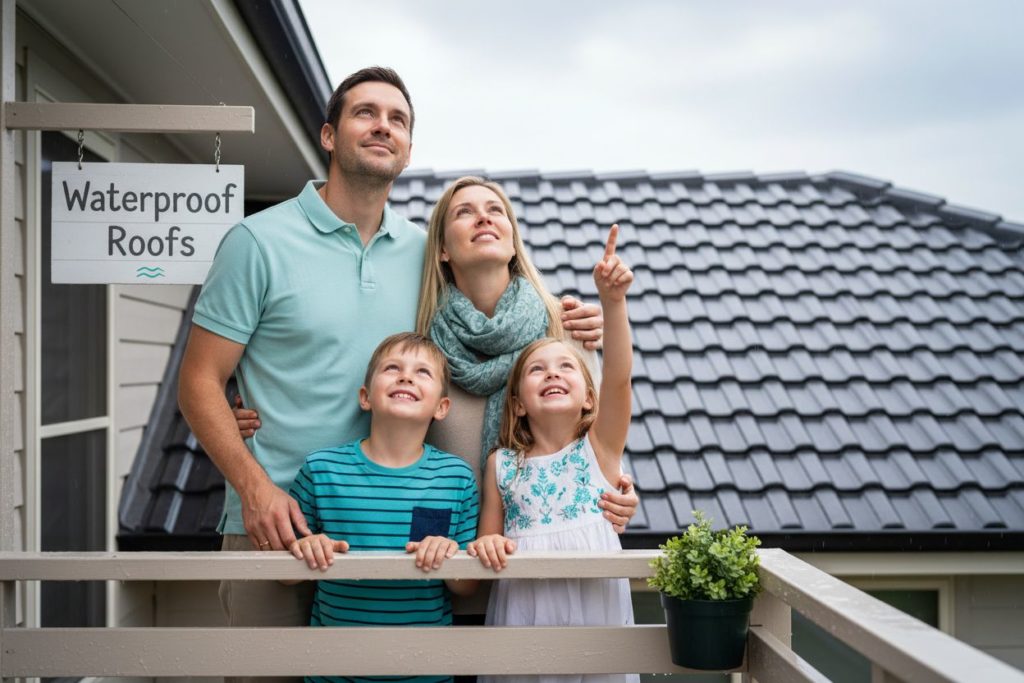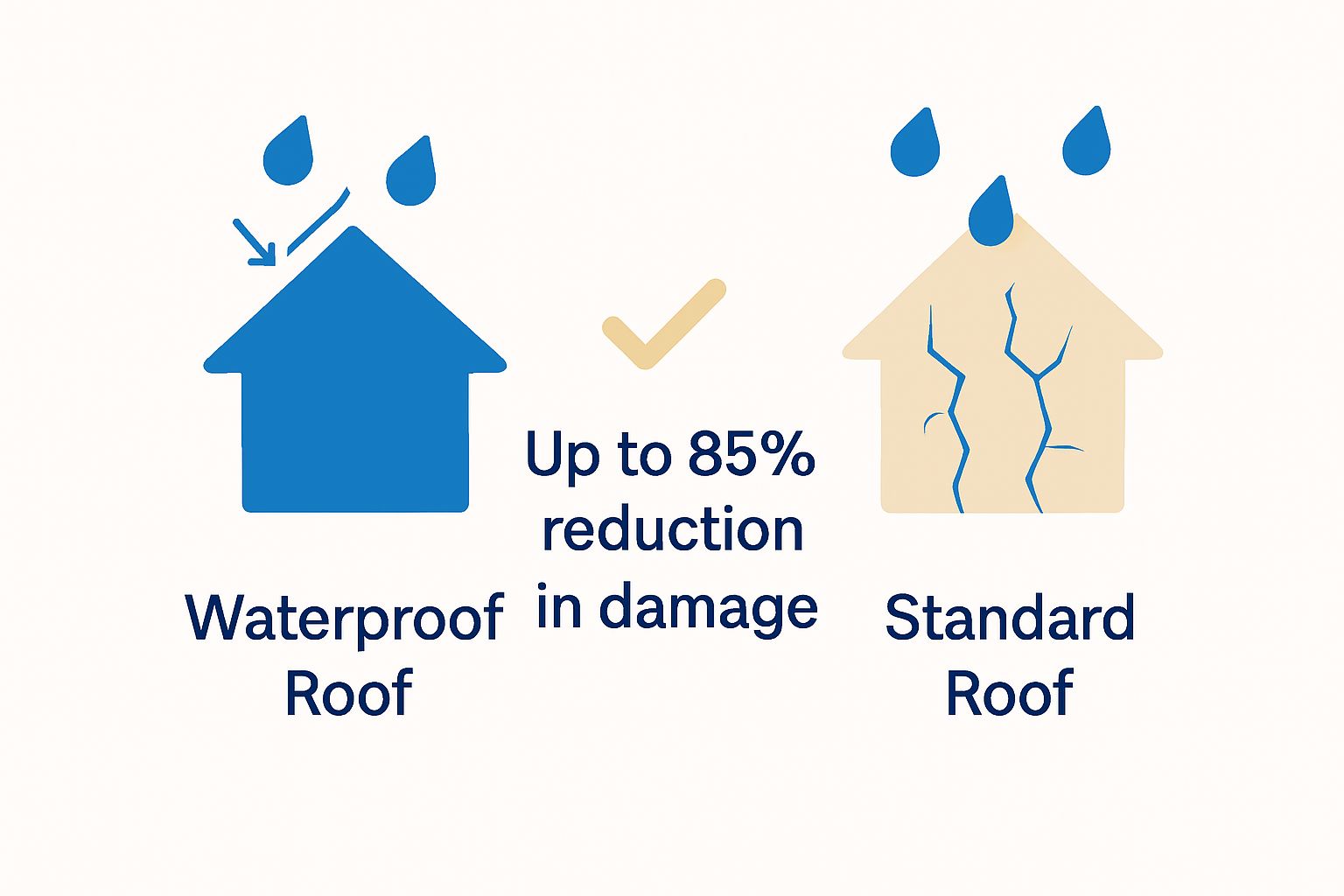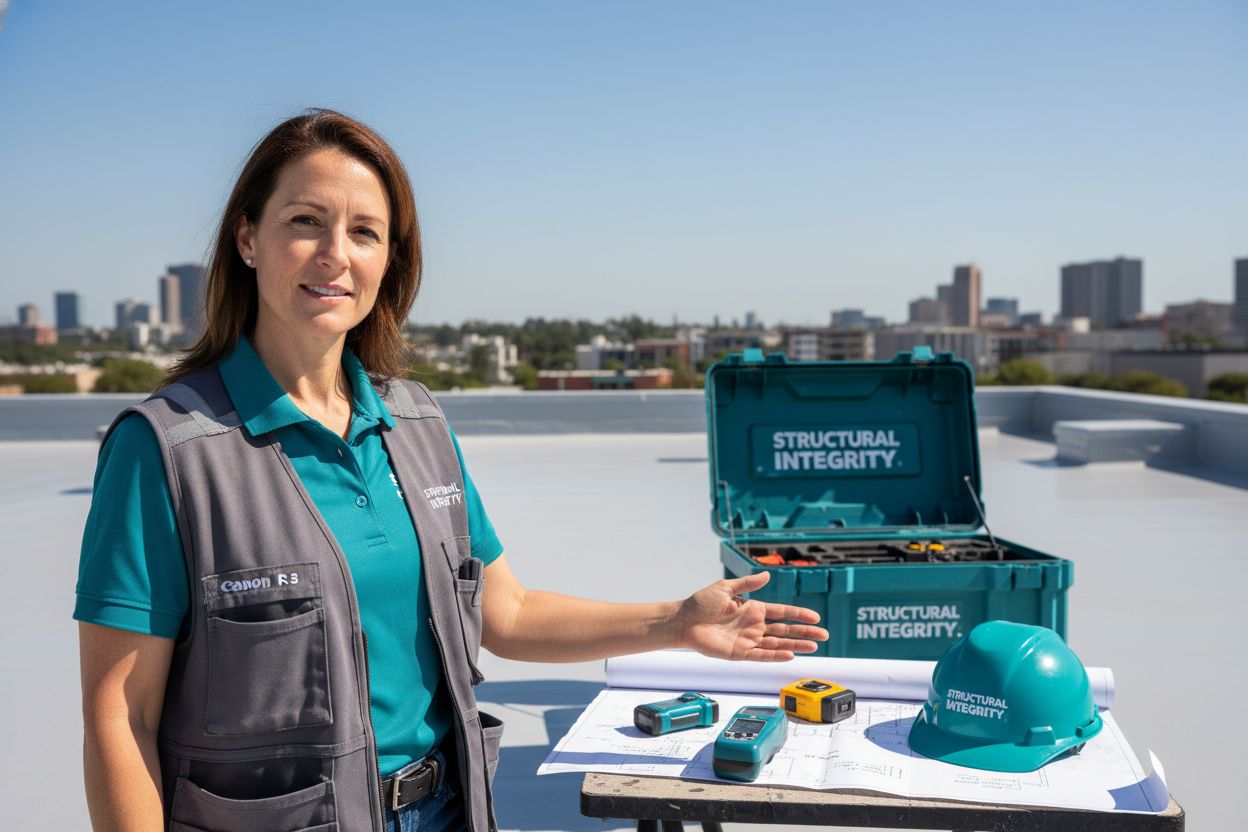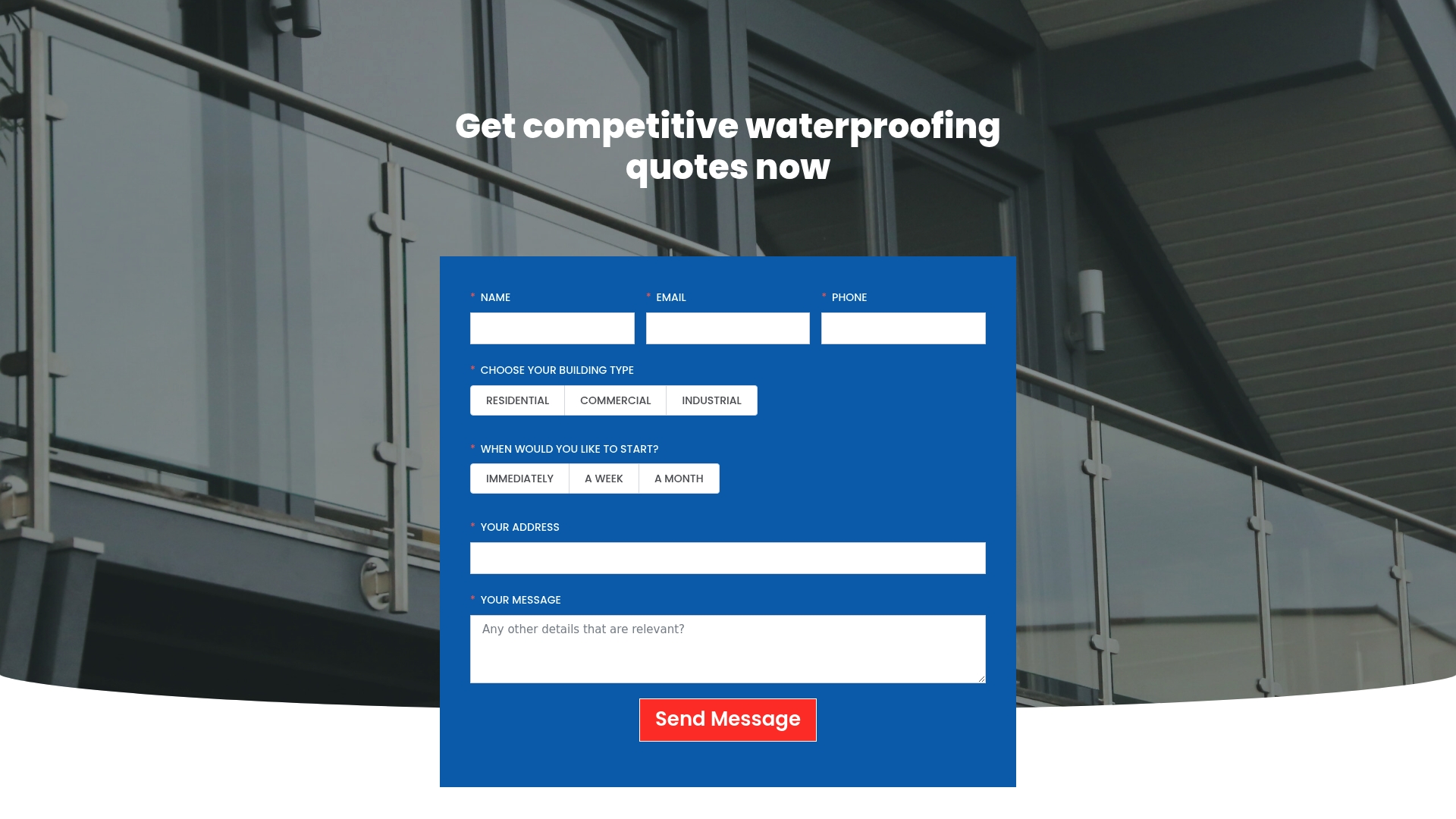Everyone knows a leaky roof can wreak havoc on a building but most do not realise that traditional roofing leaves structures shockingly vulnerable. Waterproof roofs can reduce potential structural damage by up to 85 percent compared to standard systems. Oddly enough, the real surprise is that the most advanced waterproof roofs go far beyond stopping leaks and actually help preserve a building’s lifespan while slashing energy bills too.
Table of Contents
- What Are Waterproof Roofs?
- The Importance Of Waterproofing In Construction
- How Waterproof Roofs Function And Protect Properties
- Key Benefits Of Installing Waterproof Roofs
Quick Summary
| Takeaway | Explanation |
|---|---|
| Waterproof roofs prevent water damage | These roofs create an impenetrable barrier that significantly reduces moisture infiltration and structural decay. |
| Proper waterproofing can extend lifespan by 50% | Investing in waterproof solutions can enhance the longevity of buildings compared to traditional roofs, safeguarding structural integrity. |
| Advanced materials enhance energy efficiency | Waterproof roofs improve thermal regulation, potentially lowering energy consumption by 20-30%. |
| Moisture control mitigates costly repairs | Effective waterproofing significantly reduces the risk of extensive repairs caused by water-related damages to structures. |
| Sophisticated techniques ensure long-term protection | The combination of innovative engineering and materials provides solid defence against environmental moisture challenges. |
What Are Waterproof Roofs?
Waterproof roofs represent a sophisticated protective system designed to prevent water penetration and moisture damage in buildings. These specialised roofing solutions go beyond traditional roofing materials by incorporating advanced technologies and treatments that create an impenetrable barrier against water infiltration.
The Core Concept of Waterproofing
At its fundamental level, a waterproof roof is engineered to repel water completely, ensuring that no moisture can seep through the roofing structure. This involves using specialised membranes, coatings, and materials that create a seamless protective layer. According to building research from the International Waterproofing Association, waterproof roofs can reduce potential structural damage by up to 85% compared to standard roofing systems.
Key characteristics of waterproof roofs include:
- Complete resistance to water penetration
- Ability to withstand extreme weather conditions
- Long-term protection against structural degradation
- Enhanced durability and lifespan of the building structure
Technical Mechanisms of Water Resistance
Waterproof roofs function through multiple sophisticated mechanisms. These include hydrophobic materials that actively repel water, specialized membrane layers that create a continuous protective shield, and strategic design elements that redirect water flow. Structural engineering experts at Cape Peninsula University of Technology emphasize that modern waterproofing techniques involve complex material science and precise engineering principles.
By combining advanced materials like synthetic polymers, elastomeric coatings, and precision-engineered membranes, waterproof roofs provide comprehensive protection.
Property owners can learn more about comprehensive roof protection strategies with our detailed guide on roof waterproofing.
Understanding waterproof roofs is crucial for property owners seeking to protect their investments from potential water damage, structural deterioration, and costly repairs.
Below is a table summarising the key differences between traditional roofing systems and advanced waterproof roofing, based on structural, economic, and performance criteria discussed in the article.
| Feature/Aspect | Traditional Roofing | Advanced Waterproof Roofing |
|---|---|---|
| Water Resistance | Partial; prone to leakage | Complete; creates an impenetrable barrier |
| Structural Longevity | Standard lifespan; vulnerable | Lifespan extended by up to 50% |
| Risk of Structural Damage | High (up to 85% more risk) | Significantly reduced (up to 85% lower) |
| Material Technology | Conventional materials | Advanced polymers, membranes, coatings |
| Energy Efficiency | Limited | Improved; reduces energy use by 20-30% |
| Maintenance Frequency | More frequent repair required | Lower due to enhanced protection |
| Typical Installation Context | Older or basic builds | Modern builds; high-value investments |
The Importance of Waterproofing in Construction
Waterproofing represents a critical defensive strategy in modern construction, serving as a fundamental protective mechanism against potential structural damage and environmental challenges. Beyond mere surface treatment, waterproofing is an essential engineering approach that safeguards buildings from comprehensive moisture-related risks.
Structural Integrity and Long-Term Protection
Construction waterproofing plays a pivotal role in maintaining a building’s structural integrity. Water infiltration can cause catastrophic damage to foundations, walls, and structural elements, leading to significant repair costs and potential safety hazards. Research from the South African Construction Industry Development Board indicates that moisture-related structural damages can reduce a building’s lifespan by up to 40% if not adequately addressed.
Critical areas where waterproofing becomes paramount include:
- Building foundations
- Basement and underground structures
- External wall systems
- Roof and ceiling interfaces
- Exterior balconies and terraces
Economic and Environmental Implications
The economic rationale for robust waterproofing extends far beyond immediate structural protection. Preventative waterproofing significantly reduces long-term maintenance expenses, mitigating potential repair costs that can escalate exponentially when water damage becomes systemic. Environmental research from the Council for Scientific and Industrial Research suggests that effective waterproofing contributes to sustainable building practices by reducing material waste and extending infrastructure longevity.
Property owners can discover comprehensive insights into building waterproofing strategies with our detailed guide, which explores the nuanced approaches to protecting architectural investments.
Ultimately, waterproofing in construction is not merely an optional enhancement but a critical investment in building resilience, safety, and long-term value preservation. By implementing sophisticated waterproofing techniques, property owners can ensure their structures remain robust, functional, and protected against the persistent challenges posed by moisture and environmental degradation.
How Waterproof Roofs Function and Protect Properties
Waterproof roofs operate through sophisticated engineering principles that create a comprehensive defence system against moisture intrusion. These advanced protective mechanisms transform traditional roofing from a basic shelter into a dynamic, intelligent barrier that actively repels and manages water exposure.
Layered Defence Mechanism
The functionality of waterproof roofs relies on intricate, multi-layered protection strategies. Each layer serves a specific purpose in preventing water penetration, working collaboratively to ensure complete structural integrity. Building science experts from the University of Pretoria explain that these systems typically comprise several critical components:
- Primary waterproof membrane
- Protective coating layer
- Drainage and moisture redirection systems
- Structural reinforcement elements
- Sealed connection points and interfaces
Advanced Material Technologies
Modern waterproof roofing leverages cutting-edge material sciences to create unprecedented moisture resistance. Synthetic polymers, elastomeric compounds, and nano-engineered materials enable roofs to adapt dynamically to environmental conditions. These materials possess remarkable properties such as self-healing capabilities and molecular-level water repellence.
The following table highlights core components of a modern multi-layered waterproof roofing system and their specific protective roles, as described in the article.
| Component | Protective Function |
|---|---|
| Primary Waterproof Membrane | Main barrier; stops water ingress |
| Protective Coating Layer | Shields membrane from UV, wear, and physical damage |
| Drainage and Moisture Redirection | Channels water away to prevent pooling or infiltration |
| Structural Reinforcement Elements | Provides stability; resists stress and deformation |
| Sealed Connection Points & Interfaces | Prevents seepage at joints, corners, and transitions |
Structural engineering research from the Council for Scientific and Industrial Research demonstrates that advanced waterproofing technologies can reduce water infiltration risks by up to 95% compared to traditional roofing methods. Property owners can explore comprehensive strategies for protecting their roof structures with our expert guide.
Waterproof roofs function as intelligent, responsive systems that go beyond simple water blockage. By combining precise engineering, advanced materials, and strategic design, these roofing solutions provide comprehensive protection against environmental challenges, ensuring long-term structural preservation and property value maintenance.
Key Benefits of Installing Waterproof Roofs
Installing waterproof roofs represents a strategic investment that delivers multifaceted advantages for property owners, extending far beyond basic structural protection. These sophisticated roofing solutions offer comprehensive benefits that significantly enhance a building’s performance, durability, and overall economic value.
Structural Preservation and Longevity
Waterproof roofs provide critical protection against progressive structural deterioration. Moisture infiltration can cause extensive damage to building foundations, walls, and internal structures, leading to expensive repairs and potential safety compromises. Research from the South African Institute of Civil Engineering highlights that properly installed waterproof roofing can extend a building’s structural lifespan by up to 50% compared to traditional roofing systems.
Key structural benefits include:
- Prevention of wood rot and metal corrosion
- Mitigation of foundation weakening
- Reduction of internal structural stress
- Protection against mould and mildew growth
- Preservation of insulation effectiveness
Economic and Energy Efficiency Advantages
Beyond structural protection, waterproof roofs deliver significant economic benefits. These advanced roofing systems contribute to enhanced energy efficiency, reducing heat transfer and minimizing thermal losses. Energy research from the National Energy Efficiency Agency demonstrates that properly waterproofed and insulated roofs can reduce energy consumption by approximately 20-30% through improved thermal regulation.
Property owners can discover comprehensive insights about roof installation considerations with our expert guide, which provides detailed strategies for maximizing roofing investments.
Ultimately, waterproof roofs transcend traditional roofing expectations, functioning as intelligent, proactive systems that protect, preserve, and enhance property value. By combining advanced materials, precise engineering, and strategic design, these roofing solutions offer property owners a robust defence against environmental challenges while delivering substantial long-term economic and structural benefits.
Take Action to Safeguard Your Property Against Costly Water Damage
Persistent leaks, damp patches and structural decay are common nightmares for property owners who overlook the importance of waterproof roofs. As highlighted in the article, the true threat lies not only in visible water intrusion but also in hidden moisture that gradually undermines your investment. Are you ready to prevent these issues and enjoy peace of mind?
Trust the expertise of Pro Waterproofing to deliver proven solutions tailored to your property’s needs. Our skilled team applies industry-leading techniques that address the very problems discussed in our in-depth articles, ensuring long-term protection. Explore more about our approach and see why so many choose us by visiting the Uncategorized – Pro Waterproofing category for further insights. Act now to avoid future repairs—request your no-obligation quote and partnership with professionals who care about the integrity of your building.
Frequently Asked Questions
What are waterproof roofs?
Waterproof roofs are specialised roofing systems designed to prevent water penetration and moisture damage in buildings. They incorporate advanced materials and technologies that create an impenetrable barrier against water infiltration.
How do waterproof roofs protect properties?
Waterproof roofs protect properties by using a multi-layered defence mechanism, which includes primary waterproof membranes, protective coatings, and drainage systems. This sophisticated design actively repels water and redirects moisture flow, helping maintain structural integrity.
What are the benefits of installing waterproof roofs?
Installing waterproof roofs provides benefits such as structural preservation, durability, and enhanced energy efficiency. They prevent moisture-related damage, extend the lifespan of the building, and can reduce energy consumption by improving thermal regulation.
Why is waterproofing important in construction?
Waterproofing is crucial in construction as it safeguards buildings from moisture-related risks, which can lead to significant structural damage and repair costs. Effective waterproofing ensures long-term protection and contributes to the building’s overall stability and safety.




